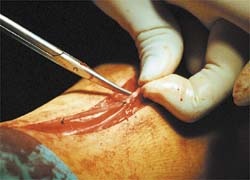Coronary Heart Disease
Media image versus patient reality
With ever-improving stents, cardiologists can deal with ever more complex cases. Will bypass surgery soon be a thing of the past?

Cardiac surgeons are increasingly asked this question not only by doctors, but also patients. There are two reasons: With ever-improving stents, interventional cardiologists can deal with ever more complex cases – and achieve more media attention, even in this publication. This increased attention results from many randomised, controlled studies that compare coronary artery bypass grafting (CABG) with percutaneous coronary intervention (PCI), i.e. surgical care with cardiac care, neither of which show any significant differences in morbidity rate or mortality. Therefore, people assume that the two procedures are on a par. According to cardiologists, the most significant advantage of the operation – the low rate of repeat procedures required - will soon be a thing of the past due to new, drug-eluting stents.
However, most of the studies do not reflect reality, according to experts in the Guideline Commission of the Germany Society for Thoracic and Cardiovascular Surgery. ‘No one doubts the accuracy of the stent-studies,’ said Professor Hans-Reinhard Zerkowski, at the society’s annual general meeting in Hamburg. ‘But they just do not reflect patient reality!’ In 13 studies analysed, only four percent of screened patients were actually included in the studies – a selection that does prompt the question as to whether the results discovered in this way are actually likely to apply to the ‘remaining’ 96% of patients.
It is also noticeable that up to 70% of patients included in these studies suffered from one-vessel or two-vessel coronary disease with normal heart pump function – a combination for which it has long been known that these patients don’t actually benefit from bypass operations (Yusuf et al, Lancet 1994;344:563-70).
This criticism of the selective perception was backed up by the propensity analysis carried out by the cardiology department at the Cleveland Clinic, Ohio, USA (Brener et al, Circulation 2004;109:2290-5). This study looked at the long-term survival of 6,033 patients who had to be revascularized at the clinic between 1995 and 1999. Where the mortality for PCI patients was 5% at one year, it was only 4% among CABG patients. After five years this ratio was 16% versus 14%, i.e. the difference had increased to two percentage points – and this with significantly increased co-morbidity among the patients left to the care of the surgeons. After the risk adjustment this advantage became statistically highly significant (p<0.001)!
The observation study carried out by Hannan (N Engl J Med 2005;352:2174-83) goes one step further and, with 59,314 patients of the New York Registry for CABG and PCI with stent involved, gives us the most realistic and comprehensive picture of reality. Apart from a significantly higher proportion of re-interventions among the PCI group, in the long term – after risk adjustment in all morphological constellations – there is a significant increase in the survival advantage for CABG.
For one-vessel or two-vessel coronary diseases without stem stenosis and without involvement of the proximal LAD there are no prognostic differences between CABG and PCI. With three-vessel coronary disease, with or without main stem- and/or proximal LAD stenosis, CABG offers patients a clear survival advantage compared with PCI – so media reality does not reflect the reality for patients.
30.08.2006









